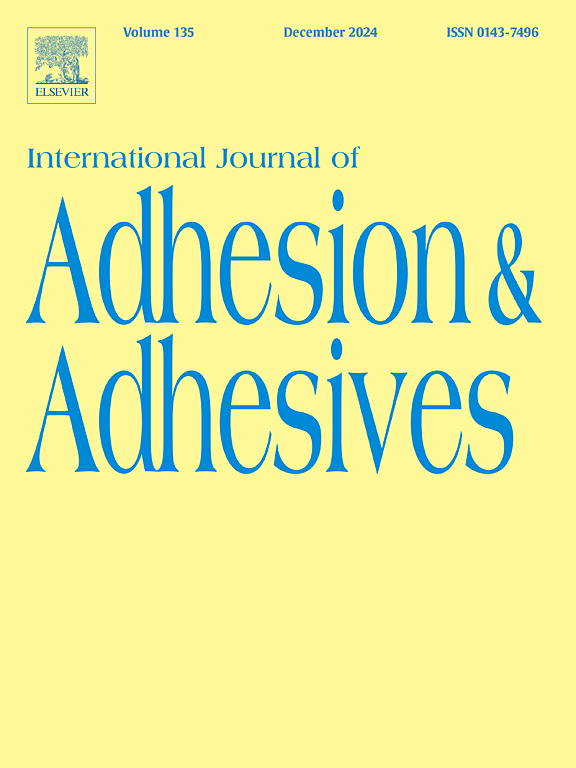Characterization of bamboo particleboard bonded with Nelumbo nucifera seed starch-citric acid-based adhesive
IF 3.2
3区 材料科学
Q2 ENGINEERING, CHEMICAL
International Journal of Adhesion and Adhesives
Pub Date : 2025-01-04
DOI:10.1016/j.ijadhadh.2025.103937
引用次数: 0
Abstract
This study evaluates bio-based Nelumbo nucifera starch-citric acid adhesives as sustainable alternatives to urea-formaldehyde for bamboo particleboard fabrication. Particleboards were produced using Semantan bamboo (Gigantochloa scortechinii) particles with three adhesive formulations: BPS100 (100 % starch), BPS75 (75 % starch, 25 % citric acid), and BPS50 (50 % starch, 50 % citric acid), targeting a density of 0.80 g/cm³ according to ASTM D1037 standards. Physical properties, including thickness swelling and water absorption, were assessed alongside mechanical properties such as modulus of rupture (MOR) and internal bond (IB) strength. The BPS50 formulation exhibited the lowest thickness swelling (76.85 %) and water absorption (134.5 %), as well as the highest MOR (5.448 MPa) and IB strength (0.372 MPa), outperforming both BPS75 and BPS100. However, the MOR value remains below the minimum required standard for general purposed particleboard, indicating the need for further development. FTIR analysis confirmed the formation of ester linkages between starch and citric acid, with enhanced carbonyl signals correlating with improved properties. While these findings highlight the potential of starch-citric acid adhesives as renewable, formaldehyde-free bio-adhesives for lignocellulosic particleboard composites, further optimization is necessary to meet industrial performance standards.
莲子淀粉-柠檬酸基胶粘剂粘接竹刨花板的性能研究
本研究评估了生物基莲淀粉-柠檬酸胶粘剂作为竹刨花板制造中脲醛的可持续替代品。刨花板是用生竹材(Gigantochloa scortechinii)颗粒和三种粘合剂配方生产的:BPS100(100%淀粉),BPS75(75%淀粉,25%柠檬酸)和BPS50(50%淀粉,50%柠檬酸),根据ASTM D1037标准,目标密度为0.80 g/cm³。除了断裂模量(MOR)和内部粘结强度(IB)等机械性能外,还评估了包括厚度膨胀和吸水率在内的物理性能。BPS50的厚度膨胀率最低(76.85%),吸水率最低(134.5%),MOR最高(5.448 MPa), IB强度最高(0.372 MPa),优于BPS75和BPS100。然而,MOR值仍然低于通用刨花板的最低要求标准,表明需要进一步开发。FTIR分析证实淀粉和柠檬酸之间形成酯键,羰基信号增强与性能改善相关。虽然这些发现强调了淀粉-柠檬酸粘合剂作为木质纤维素刨花板复合材料的可再生、无甲醛生物粘合剂的潜力,但为了满足工业性能标准,还需要进一步优化。
本文章由计算机程序翻译,如有差异,请以英文原文为准。
求助全文
约1分钟内获得全文
求助全文
来源期刊

International Journal of Adhesion and Adhesives
工程技术-材料科学:综合
CiteScore
6.90
自引率
8.80%
发文量
200
审稿时长
8.3 months
期刊介绍:
The International Journal of Adhesion and Adhesives draws together the many aspects of the science and technology of adhesive materials, from fundamental research and development work to industrial applications. Subject areas covered include: interfacial interactions, surface chemistry, methods of testing, accumulation of test data on physical and mechanical properties, environmental effects, new adhesive materials, sealants, design of bonded joints, and manufacturing technology.
 求助内容:
求助内容: 应助结果提醒方式:
应助结果提醒方式:


